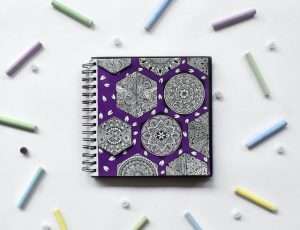Even though abstract art is one of the most popular artistic styles of today, it has a history that dates back thousands of years. Geometric art is an artistic term used to describe any type of art that uses geometric shapes and patterns as the primary elements in the composition. Geometric art emerged out of a need to create designs and patterns that could be replicated by hand. The first geometric art was created using just a compass and ruler, but over time artists began using more advanced techniques to make their designs more detailed and intricate.
Artist have used geometric shapes and patterns in their work throughout history, from ancient Egypt through present day. In this blog we will explore some of these pieces of work with an emphasis on their context in history. We’ll also find out about some of the different techniques used to create geometric art, such as tessellations, pointillism, and mosaics.
By exploring the history of geometric art we begin to understand how this style has evolved over time, which gives us a better understanding of where it stands today.
Most of us are familiar with the magnificent geometric art of Islamic mosaics and Persian rugs. Yet few realize that Geometric Art can also be found in Christian architecture and European tapestries.
Geometric Art is a form of Islamic Art, but Islamic Art has borrowed heavily from Early Christian Architecture, which itself was inspired by the Roman Empire’s use of geometric shapes.
Geometric art does not necessarily involve Islamic or Christian symbolism. In the case of this blog, geometric art is defined as anything that utilizes patterns and shapes to create an aesthetic experience.
This entry is a brief overview of geometric/abstract art. It is not intended to be comprehensive, but to give a general guide to the different styles of art.
Image:Klimt’s The Kiss, 1907**
Geometric art is not just one style, but many: Cubism, Expressionism, Futurism, Art Deco, Constructivism and Minimalism are all geometric in some way. However at its root geometric art is based on geometry. The earliest examples of geometric art come from 3000 BC Mesopotamia where they used geometry to create a sense of order and balance in their designs which they believed reflected their most important values. This geometry was then combined with other forms of art such as sculpture and painting to create beautiful images which could communicate these shared values to the people.
This idea was taken up again by the Egyptians who used similar principles for their pyramids and temples. In Egypt it was seen as a major design principle that everything should be in proportion, this meant that even pictures were drawn to fit exactly into the borders which surrounded them. It wasn’t until the Greeks that geometry became associated with abstract ideas about beauty rather than just the decorative element it had previously been. Aesthetics (the philosophy of beauty) started to become
Geometric art is one of the oldest forms of art, with a history of over 6,000 years. The earliest geometric designs found in the archaeological record are from Neolithic sites in Çatalhöyük and Jericho. These designs have simple repeated shapes that are easy to create and decorate a wide variety of objects from body ornaments to pottery vessels.
Geometric designs were also popular in Ancient Egypt where they were used as a way to represent deities. The hieroglyphs were usually arranged in patterns to represent their meaning.
Taoist philosophy was also influenced by geometric patterns which were incorporated into their religion and rituals. Taoism believes that these repeating shapes hold the key to universal harmony which is represented through geometry.
Most geometric art was made with a compass and a straight edge. A compass is a pointed metal object with a pivot point. The pivot point allows the compass to swing freely on an axis. The artist secures the end of the compass in a stationary position and then rotates it around this point, drawing a circle. To make a closed form, such as a circle or square, the artist starts at any point inside the form, then draws an arc to return to that point. To draw an arc, he keeps his arm steady, but pivots the rest of his body to trace the circumference of the circle or square.
This is hard to do accurately. If you try it yourself you will see that it’s hard to keep your hand from trembling as you draw large arcs, so your circles will tend to wobble. For this reason many geometric drawings are not drawn with a compass, but instead are constructed by combining smaller circles or arcs which are carefully drawn.
One way to combine circles is with an adjustable set square (also called a trammel). An adjustable set square has two legs joined at right angles by a hinge, and one leg can be rotated through ninety degrees relative to the other leg, like this:
The legs of an adjustable set square
Geometric art is an ancient style of art created by the Greeks. The word geometric comes from the Greek word meaning “earth measurer.” Geometric art uses shapes, patterns and symbols to tell stories or convey information. It is a type of non-figurative art that uses symbols to create images representing real or imagined things.
Telling Stories With Geometric Art
Geometric art often told stories by creating a picture that looks like a narrative scene. The two most popular ways to tell a story were with pottery and stone vases, although some stories were told with paintings on walls or murals. The geometric artist would use several different shapes to represent the characters in the story, for example: circles for their heads and spheres for their bodies.
Geometric designs were also used to decorate items like dishes and plates. These designs often had religious significance and told moral tales about everyday life. The most popular stories depicted gods and heroes from Greek mythology, but geometric designs could also be used to tell secular stories as well.
Telling Information With Geometric Art
Geometric artists were often employed to create works of art that told information about history, mathematics or literature. They produced charts that showed historical events, mathematical formulas showing formulas for geometry and maps depicting
While geometry is one of the oldest and most fundamental branches of mathematics, its use in art was almost unknown until the 20th century. It was only after the publication of Piet Mondrian’s essay “Neo-Plasticism in Pictorial Art” in 1920 that artists became aware of its possibilities.
In his essay, Mondrian distinguished the construction of objects on canvas from their representation by means of lines and colors. He considered the former to be essentially abstract, while the latter was essentially realistic. It was not long before Mondrian’s ideas became integrated into artistic practice. However, this development took place largely outside Europe. In fact, it was a Russian-born artist who first made a serious contribution to the geometric movement in modern art when she moved to Paris after marrying an American painter and began painting her own abstractions based on simple geometric forms. Her work caught on quickly with young Parisian artists such as André Lhote and Jean Hélion who were influenced by Cubism and were looking for a new direction for their paintings. By 1926 the style had been christened “Tubism,” although this term never gained wide acceptance.
By 1927, Mondrian had assembled a group of like-minded artists to work with him on an artistic manifesto



